George M. Cohan In America's Theater | home
Stageography | What's New | George Washington, Jr. | The Merry Malones | Broadway Jones | 45 Minutes From Broadway | About Me | The Little Millionaire | Little Nellie Kelly | The Tavern | Seven Keys To Baldpate | Ah, Wilderness! | Get Rich Quick Wallingford | The Royal Vagabond | Discography & Filmography | Early years: 1878-1900 | Broadway Rise: 1900-1909 | Broadway Emperor: 1910-1919 | Decline & Fall: 1920-1929 | Little Johnny Jones | I'd Rather Be Right | Broadway Legend: 1930-1978 | Mailbag/Contact Me | Related Links | Articles & Thoughts | The Yankee Prince
Early years: 1878-1900
"I was born in Providence, RI, but I am trying to live it down. The event, if not one
of national importance, was associated with one that was such, for my birthday
was the Fourth Of July, 1878."
So began an article written by Cohan for Theater Magazine in 1907. This may
have been Cohan's first attempt at an autobiography but even at this juncture
the myth surrounding his birthday seems to be already well established. It wasn't
until 1943 (after Cohan's death) that biographer and theater critic Ward
Moorehouse paid a visit to Providence Rhode Island, in search of a formal birth
certificate. A medical certificate didn't exist (his mother had him at home) but he
did find his answer at St. Joseph's Church. On the baptismal record dated July 14,
1878, it read: George Michael Cohan, child of Jeremiah Cohan and Ellen Costigan
born on the 3rd day of July, 1878.
Another biographer John McCabe attempts a rebuttal of Moorehouse's findings
by claiming that both Jerry & Nellie "taught their son that a man's word was
his impregnable bond." His words are not to be taken too lightly. George
M. Cohan (while he loved publicity, and knew exactly how to market
himself), was a man who would keep his word (even if it was to his own
disadvantage). It is also possible (even if not probable) that the date on
the baptismal certificate could have been a clerical error. Throughout their
lives, his parents consistently refer to George's birthday as being July 4th.
One thing is for sure, the birthplace of George M. Cohan, is and was never in
dispute. There is even a marker at the front of 536 Wickenden Street which
sets it in stone.
George M. Cohan was the third child born to Jerry and Helen Cohan. Their
first Maude, died in childbirth. Next came Josie (1876) while they were
appearing in an Irish variety show, "The Molly Maguires."
The Cohans tried to get their son an education, but George was a problem
student. His temperament easily frustrated his teachers, and it soon became
apparent to both his parents, and George himself that the only place he could
be happy was on the stage.
"Daniel Boone On The Trail" was the first show George experienced. His
father thought his son should become an accomplished musician, and he
arranged for violin lessons. Years later, Cohan recalled the experience,
"In two weeks, I knew all there was to know about the violin. The teacher himself
said so. He sent me back to my father with a note which read, 'Impossible to
teach this boy any more. He knows it all'."

George M. age 6
Vaudeville was a tough experience for the Four Cohans. Jerry had teamed
up with a comedian named John Barker, and together they formed the
Bijou Comedy Company, playing six performances, six times a week. But
the hard work was paying off - the Four Cohans were becoming a solid
act. George now decided that his financial future wasn't going to be playing
the violin. Instead, he would twirl the baton while reciting his father's poetry.
After a miscalculation, which left the orchestra leader black and blue, George
decided to change his act once again, and follow in his father's footsteps. He
turned himself into a song-and-dance man.
Nellie Cohan recalled in a magazine article the early days of the Four Cohans
and their vaudeville struggles.
"It was a joke our pennilessness. I don't think anyone could blame me for
wanting a home I could call my own, away from some of those overly
theatrical types, and where I could raise my children without having to run
eternally for a train or rehearse in some dirty barn of a theater. But my
husband was always an optimist and he kept us happy. I could sew
adequately and thus the children were always well dressed. But lack of
money always bothered us, Mr. Cohan would never take a salary from
anyone for my work. He was just too proud. He always said that if he
couldn't earn a living he might as well just give up the show business.
And he just couldn't give it up. He couldn't and I knew that. It was a very hard
life. Sometimes we didn't have streetcar fare and we carried the children
for miles in our arms to the theater. Still, somehow, when we got to the
theater, and we put the children to sleep in a drawer or a trunk, it was
worth it because my husband made it worth it. He loved what he was
doing so much that we all caught fire from him. ......we four were
sufficient unto each other."
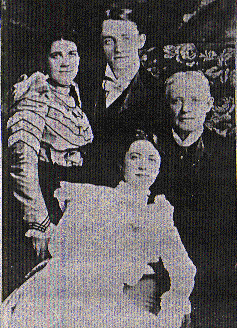
The Four Cohans (circa late 1890's)
In 1891, the Four Cohans briefly stepped out of vaudeville and appeared
in their first legitimate show, "Pecks Bad Boy." George M. had his first
starring role as Hennery Peck, the bad boy. As Hennery, Cohan
portrayed the prankish, cruel joking son, all too convincingly for the
young hoodlums that would attend the performances in the balcony.
Once in Brooklyn, young George M. was called out into the adjoining
alley. Confused, he thought it would bring him praise for his performance.
Instead, the hoodlums punched him in the jaw, and threw squishy potatoes
at him.
Cohan later stated, "The result was that for the following thirty-five weeks
I fought my way out of every popular priced alley on the ten, twenty, and
thirty cent circuit." In another article he reminisced:
"The next year it was "Peck's Bad Boy," and I was the boy. The audiences
liked that. They like the climax of the third act, for it was then that I scared
my mother into hysterics, pushed my father into a washtub full of suds,
threw a scuttle of coal into a policemen's face and tumbled the hired
girl out of the window. That went big, showing that it's other people's
troubles that we laugh at in the play."
It was a role that suited George perfectly, and one that he would use as a model
for his own play writings. The character in "George Washington Jr." is sort of like
"Peck's Bad Boy" all grown up.
But, it wasn't only as Hennery Peck that George misbehaved. His temperament
was getting beyond Jerry's control. It is reported that he made the stage hands'
life a living hell by constantly insisting on better lighting.
The family's next job came in a stock company in Buffalo.
"There I had the only real schooling of my life. We played thirty-five weeks
and thirty five parts, ranging from a boy's to an old man's character. It was
an excellent training, and really my only training."
George had a yearn to play New York, and Jerry was reluctant. He knew that
New York could be a difficult town to be successful at, even if you
weren't in show business. But George correctly figured that New York
was the center of the theatrical world, and the Four Cohans were
good enough to be a part of it. A New York engagement was arranged
on the Keith & Albee Circuit. The four of them worked hard on polishing
"The Goggles Dollhouse" a sketch that Jerry had honed for years. Keith's
Union Square Theater on 14th street was at the heart of the New York
Theater district in 1893. That night would be one that George M. Cohan would
remember for the rest of his life. Surprise upon surprise was thrust on
the Cohans. First, it was decided by Keith & Albee, that the Four Cohans
should perform separately. This threw George into a panic. Then, they
informed him that he was to open the vaudeville show (the worst possible
spot in a vaudeville show), this insulted him. Then, after performing his
dancing number he received absolutely no applause from the audience, this
infuriated him. The results were work for the family, but George was discontent.
However, this was a scene that would repeat for him another 51 times (the run
of the contract).
Contrary to George, Josie was earning rave reviews for her dancing. Here is
a highlight from a review by "The Dramatic Mirror" December 1897:
"'Noiseless as a feather or a snowflake falls did her feet touch the earth. She
seemed to float in the air and the floor to bend and wave under her as a
branch when a bird alights upon it and takes wing again.'
This sentence from Longfellow's "Hyperion" applies with full force to
charming Josephine Cohan.
Though she shines principally as a dancer, Miss Cohan is talented in other
ways. She is a gifted comedienne, and can sing a song as smartly as any
soubrette on the stage, and with those wonderful eyes of hers she can give
meaning to even the most senseless ditty."
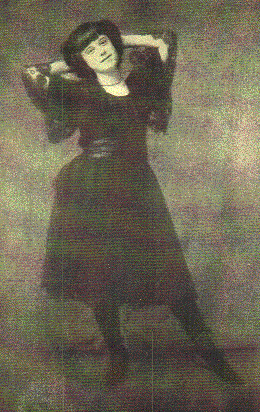
A portrait of Josie Cohan as she
appeared in the late 1890's
Jerry & Nellie were astonished to learn that vaudeville producers were willing
to pay Josie as much money to perform a single act, as they were paying for the
entire family. But Josie refused to split up the act.
At the end of 1893, George did find something that came easy to him and
he could make money at: songwriting. That winter, he wrote and sold his first
professional song entitled, "Why Did Nellie Leave Her Home." A year later,
he wrote and sold 20 more, including "Venus, My Shining Love."
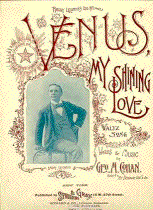
Sheet Music Cover
Cohan relates:
"My next song was "The Broadway Girl." It wasn't very bad for Lottie
Gilson sang it right out loud in public. "Venus, My Shining Love," was
my first hit. I had been reading Matthew White, Jr.'s "Argosy" and was struck
with the phrase, "Venus, My Shining Love," and used it for a title. I followed
with "Hugh McCue, You Mick, You" for Maggie Cline, and "Hot Tamale Alley"
for Mae Irwin, "The Warmest Baby In The Bunch," and I'll Guess I'll Have To
Telegraph My Baby."
Up to 1895, Jerry Cohan had starred, written, and conducted the business
aspects of the Four Cohans. But now, young George was beginning to
emerge. When time and money permitted he would often watch his
favorite performers Nat Goodwin, & Harrigan & Hart. Or, attend part of a
show at Tony Pastor's, or laugh with the audience at a Weber & Fields
Music Hall show. It was while watching these performers (and many others)
that he would analyze, and dissect their performances. If he caught a weak
moment, or false move, he would reconcile it in his mind, and often make
suggestions to the surprise and befuddlement of the performer.
After months of not receiving consecutive bookings, the Four Cohans were
invited to join Gus Williams in his show "April Fool." Everyone was grateful
for the consistent work. Everyone except George. He had read the script
and thought there was room for great improvement. This soon caused
friction between the 17 year old Cohan, and the impresario Williams, but
George remained convinced he could improve upon his part. He even
performed his own changes during the show without Williams' consent
or any of the casts' knowledge. Williams once remarked, "There's one
thing I'll say about you, Georgie. You've convinced me that capital punishment
is absolutely necessary." The Four Cohans remained in "April Fool" for 35
weeks, only after George had a roaring argument with the company manager,
the family was let go.
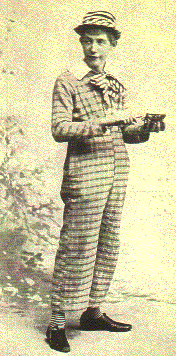
George M. Cohan in
Gus Williams' "April Fool"
In 1895, two sketches by a young, author who performed them with his
family, debuted: "The Professor's Wife," and "Money To Burn."
"The first sketch I ever wrote was for Filson and Errol, and we named it "A Tip
On The Derby." Shortly after this the Four Cohans joined Hyde's Comedians.
While with them I wrote "The Professor's Wife." Afterwards we joined Vesta
Tilley and played a sketch of mine, "Money To Burn."
As the family toured the country they continued to endure the hardships of an
unknown act in vaudeville. Then, one night, they received their big break.
The opening act for the Hyde & Behman Vaudeville Show was canceled,
and the Four Cohans were asked to open at their flagship theater in Brooklyn.
George knew better than to argue about their billing, because this could be the
Four Cohans' big break...and it was. The family received curtain call after
curtain call, for their performance, and as the audience reached a frenzied
peak, George stepped forward and addressed them.
"Ladies and gentlemen, my father thanks you, my mother thanks you, my sister
thanks you, and I thank you."
The great curtain speech of George M. Cohan was born that night. It would be
one that he would use for the rest of his life, and one that would be forever
associated with him. But, according to biographer John McCabe, "The Man
Who Owned Broadway," Cohan didn't originate it. Instead, the great curtain
speech came from an impersonator named Julian Tannen at an impromptu amateur
show where he impersonated Cohan.
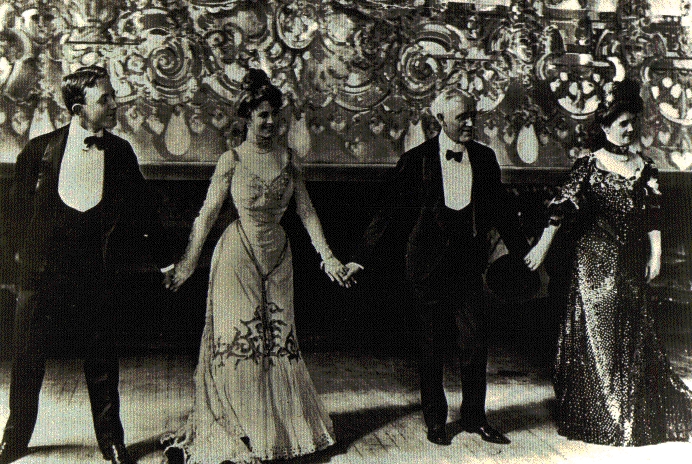
The Four Cohans during George's curtain speech (circa late 1800's).
By 1898, The Four Cohans had become well established in the vaudeville
circuits across the country. They were a top act, and could demand a better salary.
As George began to take over his father's role of family business man, he
strove to get the best he could for them. It was during these years that he
developed and perfected his own style of singing (nasal and delivered from the
side of his mouth), dancing (eccentric - see Articles and Thoughts and I'd Rather
Be Right), and personal habits (Cohan had a habit of greeting people by calling
them "Sweetheart" or "Kid." He would also thump them on the chest with the back
of his hand when an idea struck him or he wanted to express his sincerity).
He also took over negotiating for "The Four Cohans." In his autobiography,
"Twenty Years On Broadway, And What It Took To Get There," Cohan relates the
differences between his father's personality, and his own.
"My father was a very timid man, and always seemed to me to have a holy terror
of talking business, especially with the theatrical managers. His quiet, gentle
manner, and the way they used to take advantage of his let-well-enough-alone
way of going along, was a thing which taught me that aggressiveness was a very
necessary quality in dealing with the boys who were out to accumulate nickels
and dimes."
At the Casino Theater that summer, there appeared a novelty show that caught
New York audiences by storm: "Clorindy, or Origin Of The Cakewalk," with music
and book written by Will Marion Cook, and lyrics by Paul Dunbar. It caused a
sensation with its ragtime and syncopated rhythms. Their success was on the
heels of Billy Johnson & Bob Cole at being the first to bring an all black production
to a Broadway theater. However, "Clorindy" eclipsed "A Trip To Coontown," by
way of its music. Cook was a classically trained musician whose talents were
far superior to that of the minstrel style music he felt (justifiably) confined to.
Later in life, he became a tutor to Duke Ellington. But in 1898, he was full of fire
and determined to succeed, which he did. "Clorindy, or Origin Of The
Cakewalk" introduced ragtime not only to white audiences, but also to other
white songwriters. Both found it fascinating.
Cohan jumped on the bandwagon by expressing this new kind of music in his
own style. It wasn't completely ragtime, but it wasn't a waltz or 3/4 time either.
Some of his liveliest songs came from this period, including "The Warmest
Baby In The Bunch," (1897), "I Guess I'll Have To Telegraph My Baby," (1898),
& "Hannah's A Hummer," (1899).
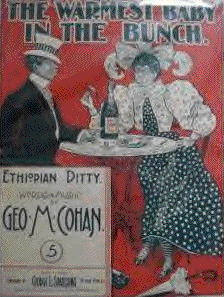
Sheet Music Cover for
"The Warmest Baby In The Bunch"
From 1897 to 1899 George M. Cohan was continually writing for and performing
with his family. He wrote 14 different sketches (including "The Governor's Son"
1898 and "Running For Office" 1897 both of which he would later expand into
full-length presentations) and dozens upon dozens of songs. He rarely had time
for his own personal life. Most of it was spent either on the stage or preparing
for the performance. Then, in September of 1898, at the Hotel Morrison in
Chicago, George attended an after theater party where he met Ethel Levey.
Ethel Levey was a dazzling performer who could belt out a song, play the piano,
dance, act, and whose charm and charisma was very similar to George's. When
they met there was a strong mutual attraction.
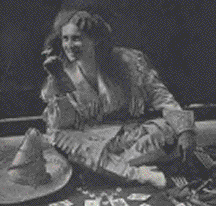
Ethel Levey
Ethel Levey was born Ethelia Fowler in 1881. She grew up in San Francisco to
Scottish and Irish parents. She later adopted the name Levey from her Jewish
step-father, Sol Levey. At the time she met Cohan, she was performing in the
chorus of "Weber & Fields' Music Hall" - in the next few months that changed.
She went into vaudeville and began singing George's songs ("I'll Guess I'll Have
To Telegraph My Baby," "Hannah's A Hummer," etc.), and her performances
made them widely popular. When George returned to New York, they
corresponded while she toured the country. George announced that he had
become engaged to his family (who were a little more level headed than
George) and they expressed their concerns. Why would George make such a
commitment for the rest of his life based upon written correspondence?
Nevertheless, in July of 1899, George Michael Cohan married Ethelia Fowler
Levey at St. Nicholas' Roman Catholic Church, in Atlantic City.
During the years of 1897 - 1899 The Four Cohans were under contract to
B.F. Keith. The Keith/Albee Vaudeville circuit was undoubtedly the strongest
monopoly the theatrical profession has ever witnessed (even stronger than
the hated Theatrical Syndicate). In an argument over billing, and
unsatisfactory/stagnate salary, George informed B. F. Keith that The Four
Cohans would never play for B.F. Keith again, and he kept his word.
With an uncertain future, The Four Cohans & Ethel looked at the dawn of a
new century.